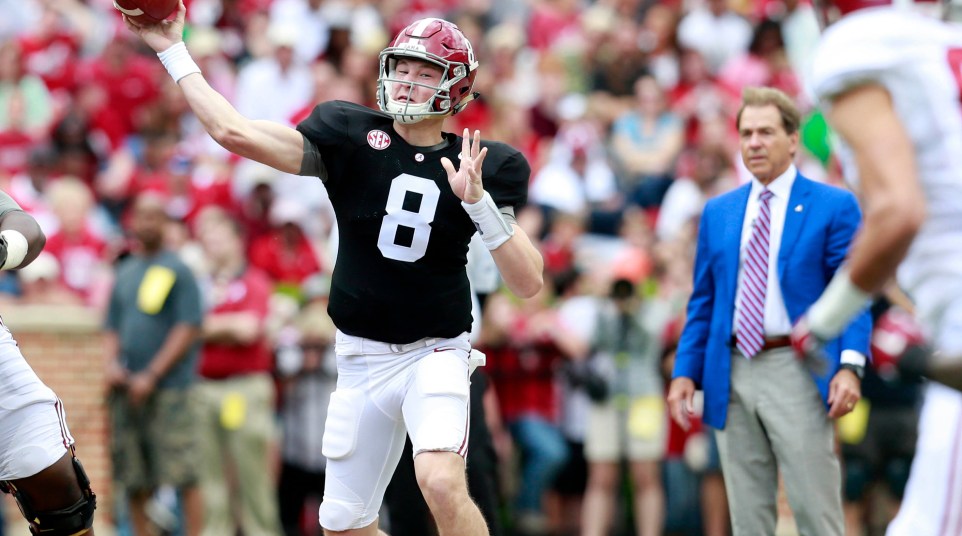
Nick Saban has transferred more than any of his players. Why is it OK for him, but not them?
Nick Saban can’t have it both ways.
He can’t rail on transfers and ignore his history.
Except, he’s a football coach, which, by definition, means of course he thinks he can have it both ways.
Football coaches are wired differently from the rest of us. They are among the most controlling people on the planet. They lead. We say OK. They say don’t post that on social media. We say OK. They do not enjoy having their opinions challenged.
Of particular interest to their management style, there is no gray in how they view the relationship between team and player. Team comes first. Always has, always will.
As such, it was no surprise that Saban exited 2016 spring ball without naming a starting quarterback, even though the answer seemed obvious: Jalen Hurts was the best Saban had. Jalen Hurts was also the youngest he had, and he had two other older, elite prospects ahead of him who trusted the process and patiently waited their time. That’s the Saban Way.
So Saban did what most coaches would: He put the team first. He didn’t name a starter.
And if you read between the lines of what Cooper Bateman and Blake Barnett told ESPN.com about that quarterback competition on Tuesday, he didn’t lead either to believe Hurts was a serious contender for the job, either.
Deceptive? Perhaps. Part of the master plan? Absolutely.
In describing the competition as a two-man race, Saban in essence guaranteed all three quarterbacks would be in Tuscaloosa when fall camp opened. He did so because that was best for the team. I wrote last spring that had Saban named a starter following the 2016 A-Day Game, somebody would have left a week later.

Credit: Kim Klement-USA TODAY Sports
Quarterbacks transfer. We don’t have to like it, but even Saban recently admitted, only one plays. And I’ve yet to encounter a 4-star recruit who didn’t want to play.
Quarterbacks transferring is not the issue.
The issue is the hypocritical, sanctimonious reaction to it.
The issue is Saban — and coaches like him — who consistently hold players to a different standard from the one they hold themselves. They demand players buy in unconditionally and forever, but don’t demand that from themselves.
Barnett noticed the difference.
“Obviously, I didn’t expect them to be happy in any way,” Barnett told ESPN.com. “The only thing I took offense to is that Saban goes out to media and tried to diminish my reputation for a decision I made that was best for my career individually. It was kind offensive that he would go out and bash a 20-year-old.”
Perhaps you haven’t thought of it this way, but Nick Saban has transferred more times than any player he will ever coach.
Saban walked out on Michigan State. He walked out on LSU. He walked out on the Miami Dolphins. He was under contract each time.
Michigan State didn’t fire him. Neither did LSU nor the Dolphins.
Saban transferred. Multiple times. For his good and the good of his family and bank account. It’s as simple and undebatable as that. That doesn’t make him wrong. That makes him human. Unless you married the first person you kissed and are still employed with the first company who hired you, you have transferred in search of better, too. We all have.
So why preach with such fire and resentment?
Recall how miffed Saban was last September after Barnett transferred?
“There’s certain things that I was taught growing up about not quitting and seeing things through,” Saban said on his radio show, according to AL.com. “If I would have come home and told my dad that I was going to quit the team, I think he would have kicked me out of the house.”
Really?
In 1999, Saban guided Michigan State to its best season in three decades. Saban quit on the Spartans just as they were preparing for a bowl game. He transferred to LSU, doubling his salary in the process, presumably moving into an even nicer house.
In February 2004, less than two months after leading LSU to the national championship, Saban signed a 7-year extension worth at least $2.3 million annually, according to the Associated Press.
“Nick Saban is the finest coach in America, and we were committed to paying him accordingly,”’ then-LSU athletic director Skip Bertman told reporters. “‘He has brought unprecedented success to this university and has built a program of championship caliber both on and off the field.”
Ten months later, Saban quit and transferred to the Miami Dolphins, but he didn’t fulfill that commitment, either. In 2007, with three years remaining on his Dolphins contract, Saban transferred to Alabama, where he quickly embarked on a decade of dominance that included four national championships.
At SEC Media Days, Saban went on a lengthy diatribe about players being committed to the cause, staying committed, doing their job, whatever their job may be, and believing in the process. Team first. Always.
That’s all fine and good. He’s clearly against the idea of players transferring. And he has a right to be.
Just like we have the right to remind him of how good he had it at Michigan State. And LSU … and in the NFL.
Each time Saban quit one opportunity, he made it better at the next. The least he could do is give his players his blessing to do the same.
